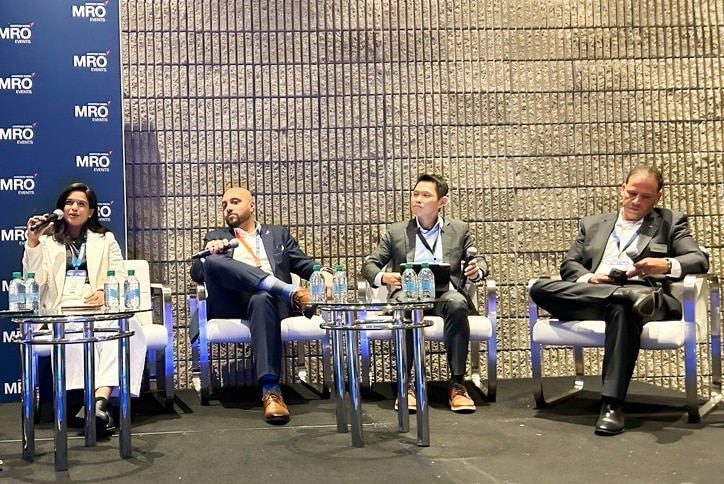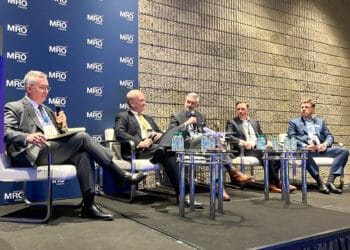MRO industry gravitates to AI for efficiency
MRO Americas 2025
The MRO industry is prioritizing the use of AI and digital platforms to provide efficient aircraft management and maintenance support.
Companies across the industry are looking for ways to improve workload efficiency while evaluating AI and digital technology options that align with their strategic initiatives, FEAM Aero Vice President of Technology Joseph Hernandez said during a panel on AI at the recent MRO Americas 2025 in Atlanta.
“We want to improve turnaround times to get aircraft back in the air, and I think everyone is looking for ways to leverage AI to help speed things up,” he said.
Companies will have to revamp their technology altogether because customers are very demanding, Tulika Dayal, chief experience officer and co-founder of Sky Select, said during the panel. San Francisco-based Sky Select is a supply chain software company that offers AI and digital platforms.
The AI solutions companies select are based on the preferenceand value they bring to their business models, Dayal said.
“I think it’s going to be a combination of both,” she added.

Aligning AI with business
The industry is in a rush to transition to AI, Gilbert Sim, director of customer-oriented results and Excellence and Technology at Pratt & Whitney, said during the discussion.
But, he cautioned, “sometimes it’s also important for us to take a step back. Really think through the areas that we should focus on because the whole world is moving so fast. People rush into the whole implementation of AI, and there are other consequences that people may not be aware of.”
When it began analyzing how to integrate AI into its ecosystem, Pratt & Whitney took into account its multigenerational workforce, Sim said.
Dayal echoed Sim’s approach to finding tech solutions that allow for an equilibrium between existing employees and the next generation.
As supply chain constraints continue to extend the turnaround time on materials, parts and components, companies are not just exploring AI platforms to increase productivity but also evaluating digital solutions that will get their internal teams communicating on the same page.
The industry must advance the development of digital solutions that simplify communication while maximizing the experience of engineers, quality and planning administrators, and aircraft mechanics to complete the repair tasks, Perwien Meriwani, senior vice president of operations and airframe at Air France Industries KLM Engineering and Maintenance, said at the event.
There is enough technology available today to digitize the entire maintenance process, which now relies on manpower, she said.
Going paperless
“We moved to digital technology and iPads a couple of years ago,” Meriwani said. “Online, it’s been highly efficient because it no longer wastes the engineer’s time going back and forth from the aircraft to the computers and checking the data findings.”
Air France-KLM is adopting tech platforms into its maintenance program to bridge the gap between its current and next-generation of aviation mechanics and engineers.
“We have a new group coming in, and the people on the shop floor tend to be used to the old-fashioned, paper job cards, and they have their way of doing it,” Meriwani said. “But this new group coming in, they’re used to different technologies, used to looking everything up.”
American Airlines Vice President of Base Maintenance Greg Emerson agreed with Air France-KLM, elaborating on the carrier’s steps to implement new technology into its maintenance protocols.
“We’re moving in that direction at a pretty fast clip,” Emerson said. “We just completely digitized everything and moved to electronic for base maintenance, and we’re moving in that direction line maintenance next year, and that’s a game-changer for us.”
The carrier’s base maintenance program, which is built around a paper task card for each repair item that averages about twenty steps for each task, has improved over the past six months since American converted to a digital format, he said.
Maximizing efficiency
FedEx has also introduced technology into its line maintenance to streamline the management of projects before integrating digital solutions into its heavier maintenance programs.
“We started a maintenance check environment where they can look at the workflow,” Vice President of Aircraft Maintenance Melvyn Stokes said. “If it’s not done within the expected time frame, it changes colors so that they can apply more resources. So that’s really been powerful, allowing us to be more efficient to insource more work with the same headcount.”
Meanwhile, independent maintenance and aircraft service provider AAR Corp has transitioned two of its six hangars to paperless operations, Rahul Ghai, senior vice president and chief technology officer, said at the event.
The digital environment enables technicians to see all their tasks on a tablet, which guides them each step, enabling them to work effectively and maximize efficiency, he said.
Register now for Cargo Facts EMEA, an essential regional event for industry stakeholders, on May 6-8 at the Shangri-La Bosphorus in Turkey.





